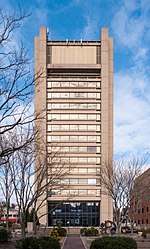Brown University is a private Ivy League research university in Providence, Rhode Island. Brown is the seventh-oldest institution of higher education in the United States, founded in 1764 as the College in the English Colony of Rhode Island and Providence Plantations. One of nine colonial colleges chartered before the American Revolution, Brown was the first college in the United States to codify in its charter that admission and instruction of students was to be equal regardless of their religious affiliation.The university is home to the oldest applied mathematics program in the United States, the oldest engineering program in the Ivy League, and the third-oldest medical program in New England. The university was one of the early doctoral-granting U.S. institutions in the late 19th century, adding masters and doctoral studies in 1887. In 1969, Brown adopted its Open Curriculum after a period of student lobbying. The new curriculum eliminated mandatory "general education" distribution requirements, made students "the architects of their own syllabus" and allowed them to take any course for a grade of satisfactory (Pass) or no-credit (Fail) which is unrecorded on external transcripts. In 1971, Brown's coordinate women's institution, Pembroke College, was fully merged into the university.
The university comprises the College, the Graduate School, Alpert Medical School, the School of Engineering, the School of Public Health and the School of Professional Studies. Brown's international programs are organized through the Watson Institute for International and Public Affairs, and the university is academically affiliated with the Marine Biological Laboratory and the Rhode Island School of Design. In conjunction with the Rhode Island School of Design, Brown offers undergraduate and graduate dual degree programs. Undergraduate admissions are among the most selective in the country, with an overall acceptance rate of 5% for the class of 2026.Brown's main campus is located in the College Hill neighborhood of Providence, Rhode Island. The university is surrounded by a federally listed architectural district with a dense concentration of Colonial-era buildings. Benefit Street, which runs along the western edge of the campus, contains one of the richest concentrations of 17th and 18th century architecture in the United States.As of March 2022, 10 Nobel Prize winners have been affiliated with Brown as alumni, faculty, or researchers, as well as seven National Humanities Medalists and ten National Medal of Science laureates. Other notable alumni include 27 Pulitzer Prize winners, 21 billionaires, 1 U.S. Supreme Court Chief Justice, 4 U.S. Secretaries of State, 99 members of the United States Congress, 57 Rhodes Scholars, 21 MacArthur Genius Fellows, and 38 Olympic medalists.










